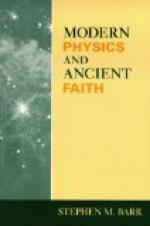The knowledge that comes through intuition tells us of matter vibrating in another great octave just beyond our own, which Science has chosen to name the etheric octave, or plane. The instant our intuition reveals the cause of phenomena our reason drops in and tells us it is the chording vibration of the matter of the two planes—the physical and etheric—that produces all physical phenomena. It goes further and explains its variations.
This knowledge of another octave or plane of matter comes from the logical relations of matter and its physical phenomena; but there was nothing in the observation or experience of mankind that would have led us to infer from reason an etheric plane of matter. It was “revealed” truth. But the flash of revelation having once made the path apparent, the light of reason carries us through all the winding ways. Our knowledge of the ether is not guess-work or fancy, any more than our geometry is, because it is based on axioms our reason cannot prove. In both cases the basic axioms are obtained from intuition; the structural work from reason. Our knowledge of the ether may be as absolute and exact as our knowledge of prakriti, working on physical as we work on geometrical axioms.
The recognition of the two sources of knowledge, the work of the spirit within us and of the mind within us, is absolutely necessary to correctly comprehend the true significance of the results of modern science and to accept the ancient.
Chapter Three
Matter and Ether
It is not worthwhile translating Homer into English unless the readers of the translation understand English.
It is not worthwhile attempting to translate the occult Eastern physics into the language of our Western and modern physics, unless those who are to read the translation understand generally and broadly what our own modern physics teach. It is not necessary that they should know all branches of our modern physics in all their minute ramifications; but it is necessary that they should understand clearly the fundamental principles upon which our scientific and technical knowledge of today rests.
These fundamental principles have been discovered and applied in the past fifty years—in the memory of the living. They have revolutionized science in all its departments. Our textbooks on Chemistry, Light, Heat, Electricity and Sound have had to be entirely re-written; and in many other departments, notably in medicine and psychology, they have yet to be re-written. Our textbooks are in a transition state, each new one going a step farther, to make the change gradual from the old forms of belief to the new, so that even Tyndall’s textbook on “Sound” is now so antedated, or antiquated, that it might have been written in darkest Africa before the pyramids were built, instead of twenty years ago.
All this change has flowed from the discovery of Faraday that there are two states or conditions of matter. In one it is revealed by one of our five senses, visible, tangible, smellable, tastable, or ponderable matter. This is matter as we know it. It may be a lump of metal or a flask of gas.




